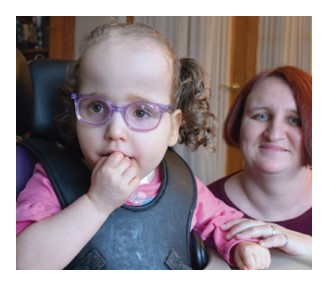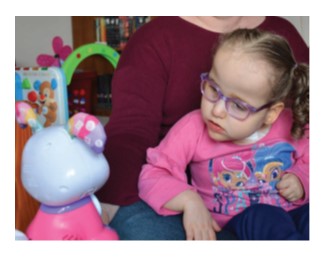Making Their Own Way
The Maloney Family Defies Predictions, Reaches Milestones With a Team Approach
 Lavender Maloney is stubborn. She gets it from her mother. From her first moments of life, she has been doing things her own way, despite predictions. “Sometimes it’s a battle of wits on who is more stubborn, me or her,” admits Lavender’s mom, Cindy. “We haven’t figured that out yet, but her stubbornness is what has gotten her here.” Lavender Maloney is stubborn. She gets it from her mother. From her first moments of life, she has been doing things her own way, despite predictions. “Sometimes it’s a battle of wits on who is more stubborn, me or her,” admits Lavender’s mom, Cindy. “We haven’t figured that out yet, but her stubbornness is what has gotten her here.”
In November 2014, Lavender was born at 23 weeks. She weighed one pound. Her hand could barely fit around her mom’s little finger. At two days old, she suffered a grade 4 IVH, which is a severe brain hemorrhage, causing the loss of two-thirds of the right side of her brain. The doctors told her mom and dad, Eric, that they did not think she would make two weeks. There was talk of do-not-resuscitate orders. But Lavender and her parents refused to give up. Stubbornness of the best kind would not allow it. “They’d ask what our plans for her were,” Cindy says, “and I would always answer that she was coming home with us.”
Lavender spent the first six months of her life at Penn State Health Milton S. Hershey Medical Center – four of those in the NICU and two at Penn State Children’s Hospital. During her time in the NICU, she was on the main floor because her condition was so severe. “If something went off, it was all hands on deck,” Cindy recounts. “There were multiple times when I got shoved back because the doctors had to get in there to figure out what was going on.”
There is no right approach taken by parents of kids who stay in the NICU for long stretches. Some parents never leave; others come and go. Cindy and Eric found a balance that worked best for them, and it helped that the couple lived in nearby Harrisburg. “Cindy was down in the NICU every
day, except for two – one because of snow and the other because of a stomach virus,” Eric says.
“You have to find what works best for everyone,” Cindy advises. “We were there and we knew what was going on, but we didn’t live there and stare at those monitors all day. Everyone has their own story. I know, for us, we couldn’t have sat there all day, every day. We learned a lot in that time period at the hospital. A lot of great nurses and therapists taught us quite a bit.”
After six months, the time came for Lavender to go home. “When we finally got her home, there were moments when I was happy to have everything here and there were tough moments,” Cindy says, remembering the first time Lavender had a plugged tracheostomy in the middle of the night.
Two days a week, Lavender receives occupational, physical and speech therapies in York County at Leg Up Farm, a nonprofit therapy center for children with special needs. In the summer of 2018, she graduated from feeding therapy. She also receives therapy through the Capital Area Intermediate Unit, where she attends preschool once a week.
“At CAIU, the idea is to transition special needs kids into school-based programs,” Cindy explains. “Their goals are very classroom-oriented, which is why I also chose to go to Leg Up Farm because it is more centered around lifeoriented goals.”
Lavender battles cerebral palsy, epilepsy, neurological damage and seizures, which began around her third birthday. However, she continues to stubbornly reach important milestones. “A year ago, I never thought I’d see her standing,” Cindy says. “Eating and drinking by mouth was also a huge accomplishment. She’s constantly making progress on sitting up on her own. She’ll travel all over the livingroom. She won’t crawl or walk, but she will roll to go get a toy. She does this all-or-nothing thing.”
Cindy and Eric share some of Lavender’s victories with others online. They are part of a worldwide cerebral palsy information group with people from as far away as Australia. Hearing the stories from other countries highlights the differences in care around the U.S. and the globe. “It makes me feel very lucky that I live in Pennsylvania because everything is covered for her through state Medicaid,” Cindy says. “Other states don’t necessarily do that. It makes me feel even luckier to be in the U.S. when I read stories from Nigeria, where they don’t have the access to the equipment we have.” 
The Maloneys share Lavender’s story in the hopes that it will inspire others. “She’s been through more at 5 years old than people have been through in their whole life,” Eric says. “Nothing is set in stone. There’s no way to tell what a child will and won’t do.”
“You have to push,” Cindy says. “Our biggest joke with Lavender is that she didn’t read the medical books and she doesn’t play by the rules most other kids in her situation do.”
The Maloneys were initially approved to receive 16 hours a day of home nursing – eight day hours and eight overnight. “At the time, the night nursing was sporadic because they didn’t have someone to cover it,” Cindy explains. “So we moved Lavender into our bedroom to see how it would go with just us and no nurse at night. We found out that I got more sleep, so we opted out of the night nurse.”
The Maloneys have a home nurse Wednesday through Friday, 10 hours each day from 8 a.m. to 6 p.m. The nurse works with Lavender on her physical therapies, feeds her and monitors her breathing. “We do this as a team, and that is one of the most important things,” Cindy says. “It has to be a group effort. I’d love to say that I am a superwoman and can do everything because that’s my mentality. But it’s not possible because I’ve tried. I’ve gone without a nurse for a month, and I was so frazzled and so upset because I couldn’t get some of the therapies done every day while trying to cook and clean. We needed an extra set of hands at least a couple of days a week. You have to realize that you need help.”
|